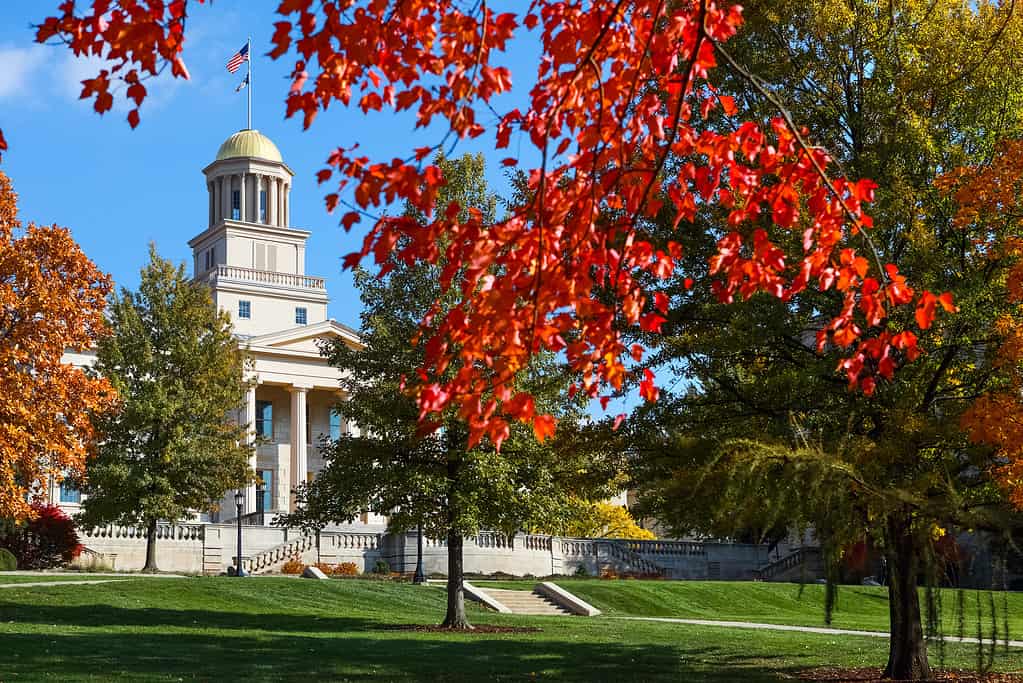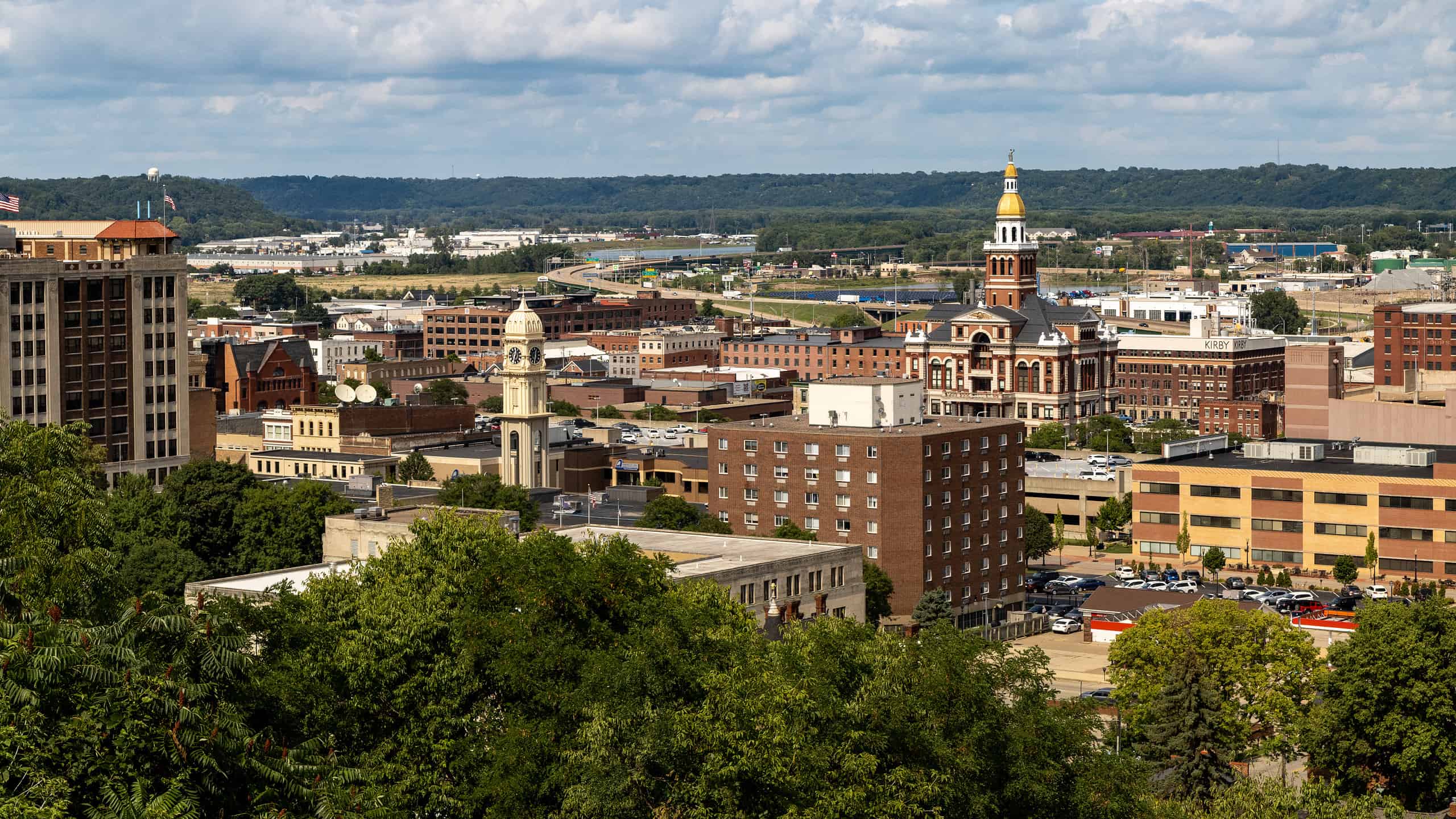
While the state didn’t become part of the U.S. until 1846, the oldest city in Iowa dates back hundreds of years. Like all settlements that eventually became part of the country, it also has a long and complicated past. In this article, we’ll take a look at the four oldest cities that shaped Iowa’s history. While they are the oldest colonial cities in the state, however, it is important to remember that the native peoples of the continent predated European colonists by millennia.
1. The Oldest City in Iowa: Dubuque
The oldest city in Iowa, Dubuque, was first settled in 1785 by French-Canadian furrier Julien Dubuque. He lived in the area alongside the native Mesquakie people. During his time there, he learned of and acquired local lead mines from the native peoples and operated them with great success for the remainder of his life.
The city of Dubuque, as it is known today, would not be chartered until 1837, several years after the seizure of the Mesquakie land by the U.S. Because of its rich mineral wealth, the area attracted many miners from the east coast. Following Julien Dubuque’s footsteps, fur trading continued to be an important industry as well. Over time, industries centering around milling and logging would develop, and the river would continue to serve a role in trade. It should come as no surprise, then, that boat-making also played an important part in the city’s development.
The development of industry along the river, while it helped develop the city, has contributed largely to the pollution that plagues the Mississippi. Various cleanup efforts have been underway along the river for many years. The city is today, part of a statewide program to monitor and document the prevalence of PFAS chemicals in local drinking water.

Dubuque, the “Julien Dubuque Monument.”
©Eddie J. Rodriquez/Shutterstock.com
2. Muscatine, 1833
The city of Muscatine took its earliest shape in 1833 when three Illinoisans set up a trading post along the Mississippi River. Later that year, a man by the name of James Casey set up shop stocking steamboats with wood. These steamboats, carrying colonists and supplies, were on their way to take over the territory that had just been forcibly taken from the native people after the Black Hawk War. Because of the importance of the stop, the settlement was first named “Casey’s Wood Yard.”
In 1836, the town received the name Newburg along with its first official plat. However, the colonists chose to change the name to Bloomington soon after. Three years later, in 1839, they began the construction of the city’s first courthouse, which would burn down 25 years later.
The town became incorporated in the same year and, due primarily to confusion within the postal circuits, received the name Muscatine. This name was likely taken from the Mascouten people who had been displaced from their homeland east of the Mississippi and settled nearby. The area they settled in was originally an island but would cease to be one later on when the Mississippi changed course.

Muscatine, Historic District.
©Shelley K/Shutterstock.com
3. Davenport, 1836
Before the United States seized the territory, the native Sauk and Mesquakie people called it their home. After the seizure became official via the Black Hawk Treaty of 1832, settlers quickly claimed the area. By 1836, it would officially become the third oldest city in Iowa.
Though it would eventually be renamed, the site was originally called Oskosh. Down the road, the city’s name would change to honor Colonel George Davenport, the city’s founder. Davenport was the same man responsible for the trading post that would become the city of Muscatine.
Several decades later, in 1856, the city would become home to the first railroad bridge to ever cross the Mississippi. The railroad’s arrival and the city’s proximity to the Mississippi River made Davenport a very successful trade hub. The industry continued to grow in the town from this point forward.
Today, the city is home to several universities and community colleges, as well as the Palmer College of Chiropractic. There are also museums of natural science, art, and history. Each year, in July, the city is host to the Bix Beiderbecke Memorial Jazz Festival, which showcases traditional jazz bands from all over the world.

Davenport, Downtown skyline from the Mississippi.
©Eddie J. Rodriquez/Shutterstock.com
4. Iowa City, 1839
Iowa City came to be in 1839, when the state’s governor, Robert Lucas, decided that the capitol should sit near the center of the new territory. The state’s capitol, originally set in Burlington, would move again in 1957 to Des Moines, where it remains to this day.
Up until the change of capitol, Iowa City experienced a population boom throughout the 1850s. Although slower after this point, the city continued its growth over the next several decades. By 1900, Iowa City was the 13th most populous city in the entire state.
Today, nearly 75,000 people call the fourth oldest city in Iowa their home. The small but bustling city is full of attractions. Music halls, parks, massive sculptures, and ancient archaeological finds are just a few of the things you’ll find there. There are also top-notch mountain bike trails!

Iowa City, Old Capitol.
©Suzanne Tucker/Shutterstock.com
Summary of the 4 Oldest Cities in Iowa
| Rank | City | Year Settled |
|---|---|---|
| 1 | Dubuque | 1785 |
| 2 | Muscatine | 1833 |
| 3 | Davenport | 1836 |
| 4 | Iowa City | 1839 |
Thank you for reading! Have some feedback for us? Contact the AZ Animals editorial team.








